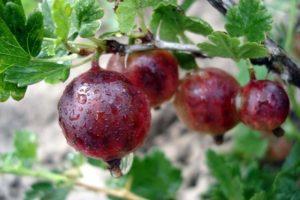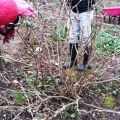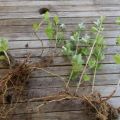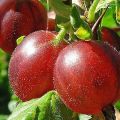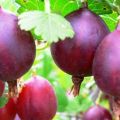Description of Rodnik gooseberries, planting and care rules
According to the description, Rodnik gooseberries have many advantages. This plant has a bountiful harvest and tasty fruits. To achieve success in growing it, it is worth following a number of recommendations. The culture needs timely soil moistening, fertilization, pruning. It is also necessary to provide protection against diseases and pests.
Breeding history
The authors of this plant were IV Popova and MN Simonova - breeders of the Moscow Institute of Horticulture. The Rodnik variety was obtained by crossing the Lada variety and the Purman seedling. In 2002, the culture was included in the State Register.
Description of gooseberry
The Rodnichok variety easily adapts to new conditions. It is characterized by a rapid build-up of green mass.
Bush
The gooseberry of this variety is characterized by compact bushes 1.2 meters high. They have strong, straight shoots and few thorns. The leaves are five-lobed and have wavy edges. The flowers are cone-shaped and have burgundy blotches.
Berries
The fruits are oval in shape and not covered with fluff. The berries are characterized by a smooth surface and a slight waxy coating. Ripe fruits are yellow with light pink patches. From above, they are covered with a thin and strong skin. Inside there is a green pulp with a small amount of seeds. The weight of the berries is 4-7 grams.

Characteristics of the Rodnik variety
Before planting gooseberries in your garden, you should familiarize yourself with its characteristics.
Ripening period
The flowering culture begins in the second half of May. The fruit is characterized by uneven ripening. The first berries can be obtained at the end of June. In this case, fruiting is stretched for 2 weeks.
The fruits should be picked immediately after ripening, as they can crumble.
Yield
The first flowers appear 2 years after planting, but the harvest during this period is small. After 4 years, full-fledged fruiting of the gooseberry begins. From 1 bush it is possible to get 10-12 kilograms of berries.
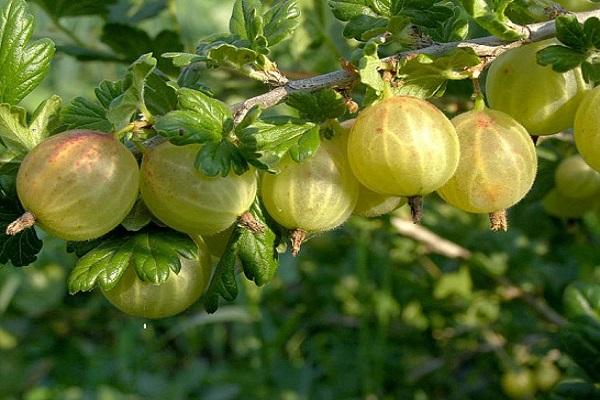
Using
The gooseberry of this variety has excellent taste. The fruits can be eaten fresh. They are used to prepare various drinks and salads. For the winter, compotes, jams, preserves are prepared from gooseberries. Berries are also suitable as a filling for baked goods.
Transportability
The fruits of this variety are characterized by a dense skin. Therefore, they can easily be transported and retain their excellent appearance. For successful transportation, berries are recommended to be picked at the stage of technical ripeness.
Drought resistance and frost resistance
The culture tolerates frost normally. Sharp temperature fluctuations do not affect the yield of the plant. Shrubs tolerate short-term drought normally.
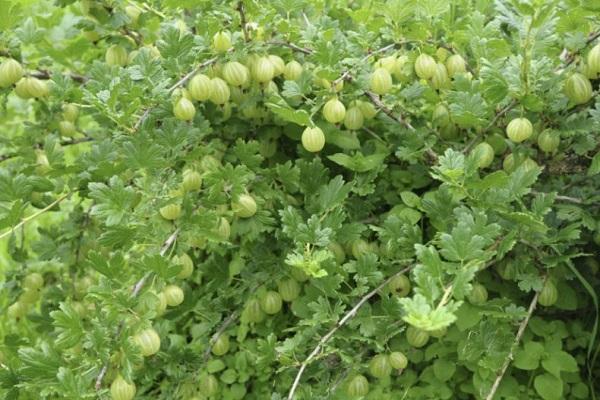
The advantages and disadvantages of culture
The key virtues of culture include the following:
- early ripening period;
- high productivity;
- excellent resistance to frost;
- resistance to temperature fluctuations;
- fast rooting;
- self-pollination;
- pleasant taste;
- a small number of thorns;
- excellent portability;
- resistance to powdery mildew and septoria;
- stable fruiting;
- universal purpose.
At the same time, the culture also has certain disadvantages:
- rapid shedding of berries in rainy weather;
- low resistance to anthracnose;
- low resistance to damage by moth and aphids.

Features of growing a plant
In order for the shrub to take on well, have resistance to frost and give a good harvest, it needs to be provided with proper care.
Boarding time
It is recommended to plant a crop in spring or autumn. In the first case, planting work is carried out immediately by melting snow. Moreover, it is important to complete them before the start of the movement of the juices. Autumn planting is considered preferable. It is best to spend it in the first half of September.
Soil selection
The plant is not recommended to be planted in waterlogged soil. Beds with a high groundwater table are not suitable for him. Loamy soil with normal acidity parameters is best suited for gooseberries.

Planting process
To plant a plant, you should follow these steps:
- 2 months before planting the culture in the ground, clear the bed of fallen leaves and, if necessary, add lime.
- Make a hole 50 centimeters deep and 1 meter wide. River sand should be added to too heavy soil.
- To prepare seedlings, they should be soaked in a growth stimulator for 2 hours. You should also cut the shoots to 5 buds.
- Dip the seedling into the hole and spread the roots. In this case, the neck should not go underground.
- Tamp the trunk circle, cover it with a layer of mulch.
Variety Care Tips
To succeed in growing a plant, he needs to provide complete and high-quality care.
Watering
If there is a lot of rainfall in the region, gooseberries do not need additional watering. If there is no rain, soil moisture is required. Water should be poured into the trunk circle.

Pruning
At the beginning of the season, it is worth pruning the plant, getting rid of old and diseased stems. It is usually worth removing branches that are 7-8 years old. They are dark in color, deformed and practically do not produce a crop. It is also worth removing thickening branches.
Top dressing
Fertilizers are recommended to be applied when planting a crop. After that, additional feeding is not required in the first year. Subsequently, it is worth following the following scheme:
- during the formation of buds, 50 grams of Nitroammofoska are used;
- during the formation of ovaries, the plant needs 150 grams of wood ash;
- during harvesting, solutions of organic fertilizers are required - you can use mullein or bird droppings;
- with the arrival of spring, urea or ammonium nitrate is added before bud break.
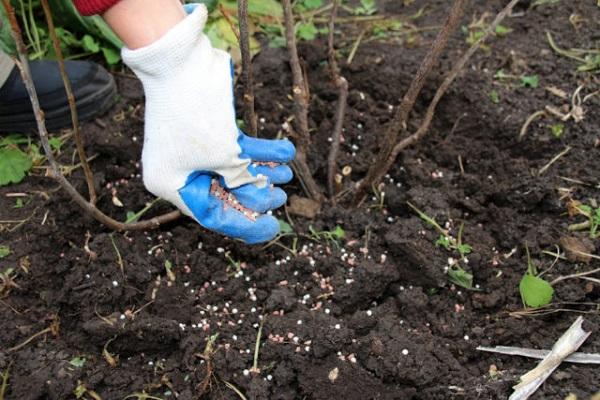
Preparing for winter
This gooseberry variety can be left uncovered for the winter. At the same time, experienced gardeners are advised to sprinkle the tree-trunk circle with sawdust. At the end of autumn, it is recommended to clear the garden of fallen leaves, branches and grass. This debris can harbor fungal spores and parasites.
Protection against diseases and pests
This plant is highly resistant to diseases and parasites. Bushes rarely encounter pathologies.
In cold and rainy weather, there is a risk of developing fungal infections. They appear as a bluish bloom on the fruit.

To cope with fungi, it is worth treating the bushes with Topaz or Oxyhom. For preventive purposes, in the spring, gooseberries are sprayed with a solution of copper sulfate. You can also use potassium hydroxide.
Gooseberries can suffer from aphid attacks. To cope with the problem, water the bush with soapy water. Removal of anthills is of no small importance.
Harvesting and storage
Fruit ripening begins at the end of June. The berries ripen amicably, so the harvest can be harvested in one go. Unripe fruits can be stored for 10 days. It is recommended to do this in a dry and cool place.
If longer storage is required, the fruits should be dried and placed in a refrigerator compartment with a temperature of 0 degrees.

The Rodnik gooseberry is considered a fairly popular plant. It is chosen by many summer residents for growing in their garden plots. This is due to the high yield and excellent taste of the fruit..

